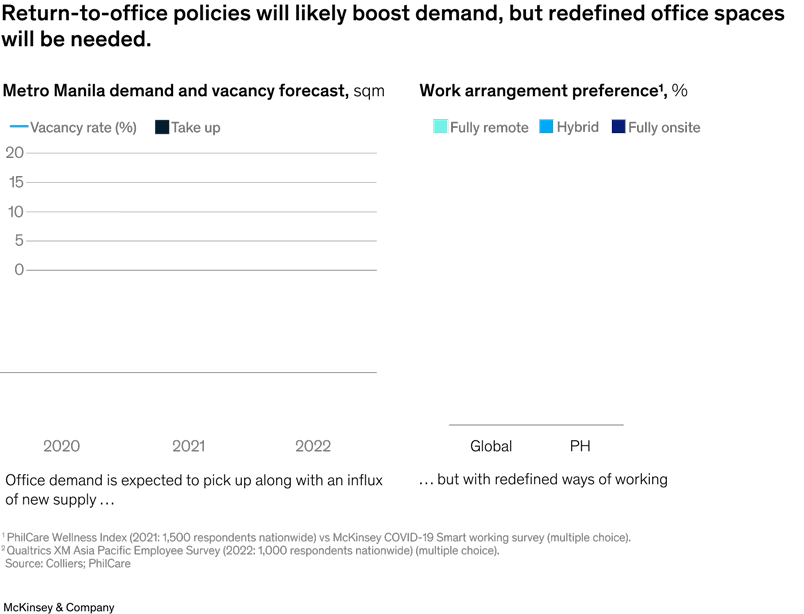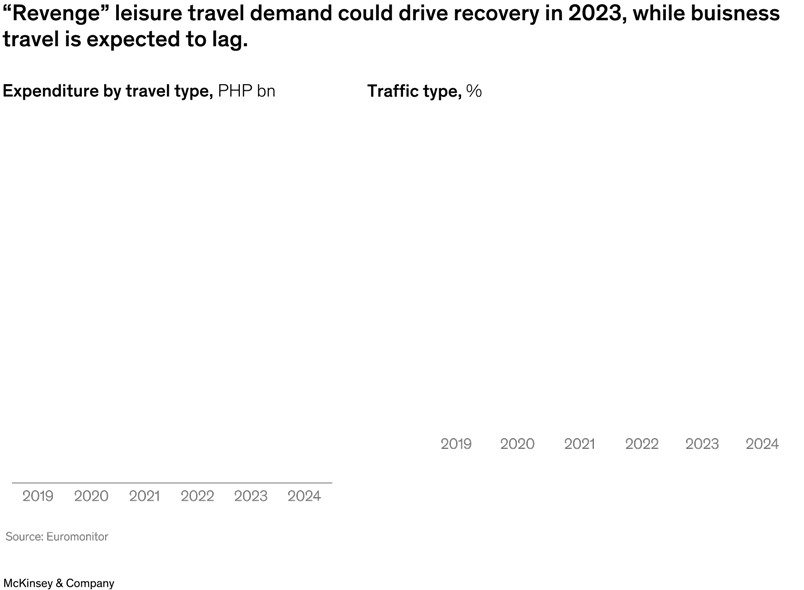The COVID-19 pandemic and other geopolitical events have caused a global crisis over the past couple of years. Major upheavals of this scale are not unknown—in the 20th century, various significant events shook the world, like both World Wars and the Cold War. Between these periods of disruption, global events played out across three “eras”: the Post-War Boom after the Second World War, the Era of Contention from 1972 to 1974, and the Era of Markets from 1989 to 1992, each of which had distinct characteristics and opportunities.
The effects of the current crisis, both humanitarian and economic, cannot be underestimated. However, as the world continues to emerge from the pandemic, business leaders can take advantage of these upheavals, and shape innovation and growth—as evidenced in previous eras—by anticipating future disruptions and shaping strategies accordingly. This kind of “era thinking” is particularly valuable in the Philippines, where disruptions caused by the conflict in Ukraine and international supply-chain crises have had a clear impact.
Looking ahead into 2023, the economic forecast for the Philippines remains a moving target. After a record 10 percent contraction in 2020, the country may bounce back in 2023 with projected growth of around 5.3 percent, though it will hardly rise above preCOVID-19 levels (exhibit).

Key challenges face the country: significantly high unemployment numbers; a high inflation rate (forecast to reach 5.1 percent in 2023); rising policy rates; import and export bottlenecks; and the declining strength of the Philippine peso against the American dollar.1
The state of the Philippines’ economy in seven major sectors
This article analyzes seven key sectors that offer a detailed insight into the state of the Philippines’ economy in 2023 and beyond. As the data shows, the outlook is complex—there are serious issues to address, but also reasons for optimism.
Real estate and construction
Several global and macroeconomic shocks will likely impact the Philippines’ post-pandemic economic recovery in the real estate and construction sectors. Policy rates may reach 6.25 percent in the first half of 2023, which would negatively impact home lending rates and increase the strain on a sector that must also address the increased costs of construction and logistics caused by supply-chain issues.

Nonetheless, more optimistic projections include an expansion in real estate investment opportunities and the emergence of green real estate, a promising step toward the Philippines’ goal to reduce carbon emissions by 75 percent by 2030.1
Much of the sector is expected to recover to pre-pandemic levels by the end of 2023, and construction by the end of 2024. Much of this growth will likely be driven by residential building construction, predicted to grow by 12 percent. Non-residential construction, by contrast, has yet to recover to pre-pandemic levels.

There will likely be an increased demand for office space, caused by companies introducing return-to-office policies, as well as a resurgence in the need for industrial, retail, and leisure spaces, both of which would boost sector-wide growth.
Another consideration is hybrid working—this is in fact higher in the Philippines than the global norm.1 Office spaces may need to be reinvented as companies look to adopt more hybrid ways of working. This could result in vacancy rates persisting, however the growth of coworking facilities and the desire for sustainable buildings will necessitate innovations in construction techniques and leasing agreements, thus encouraging sector-wide growth.

Travel and hospitality
The outlook for the travel and hospitality sector is strong, with a full recovery to pre-pandemic levels expected by 2024. Outbound and inbound travel may be sluggish due to remaining international travel restrictions and further health and safety concerns: 71 percent of Asian countries still impose travel restrictions to varying degrees; Europe is more lenient with 50 percent of countries imposing no restrictions at all.
Despite this, hotel occupancy is expected to rise as more foreign tourists visit the Philippines. China’s removal of quarantine on arrival from January 8, 2023, and Hong Kong’s withdrawal of mandatory quarantine on arrival in September 2022, are both reasons for optimism. If mainland China’s air travel were to recover at the same pace as Hong Kong’s, four million air passengers a month out of China can be expected by the second quarter of 2023, pushing air travel back up to 40 percent of pre-COVID-19 levels.

Several key trends are expected to influence economic recovery in the sector, the impacts of which may be both positive and negative. High inflation, for example, has increased airlines’ operating expenses. The weakening peso, by contrast, could have a positive effect by encouraging locals to travel and spend within the country rather than abroad. In fact, local air travel is already on the rise and is expected to reach preCOVID-19 levels in the second half of 2023.1

The growth of “revenge travel” (travelling widely and often to make up for time and opportunities lost during the COVID-19 pandemic and attendant travel restrictions) also contributes to the robust growth of leisure travel, while business travel is recovering more slowly. This is largely due to the inconsistent travel restrictions between countries, and remote working tools that do away with the necessity of meeting in person.

Sustainable tourism and increased awareness of eco-friendly travel options may not negatively affect the number of tourists visiting the Philippines, but they will likely change how visitors and locals arrive in, and travel through, the country. The fact that the hospitality industry has recovered more significantly than airlines shows this. Other contributing factors include the increase in domestic travel and the popularity of the “digital-nomad” lifestyle, which allows travelers to live and work for extended periods in their destinations of choice, rather than flying between destinations frequently.

Financial services
The strength of the Philippines’ financial services sector in 2023 will likely be subject to two key factors: interest rate hikes and rising inflation. Interest rate hikes could have a positive effect by widening the net-interest margin, but macrovolatility could cause a slowdown in new loans. Rising inflation will likely increase the pressure on wages and increase operational costs.
The financial sector is already responding to these challenges. It is prioritizing the interoperability and digitization in top banks, and the country’s central bank, Bangko Sentral ng Philipinas, is expected to increase interest rate hikes to keep up with inflation.1
Banks have taken additional steps. These include recovering nonperforming loans, reducing loan loss provisions with an outlook on improved credit status, and the emergence of digital neobanks, which offer higher savings interest rates and faster customer acquisition. Perhaps most crucially, there are growing efforts to make banking more accessible and inclusive. The growth of digital banking is significant: in 2021, 60 percent of Filipinos used digital banking (a sharp increase from 17 percent in 2019), and growth is expected to accelerate in 2023.2

Energy
Growth in the Philippines’ energy sector contracted to 4.8 percent in 2022 and is expected to rebound to 5.5 percent in 2023. However, the sector needs to ensure that this growth target can be met given looming supply constraints and while accelerating the transition to green energy.

Due to a growing population, an economy coupled with the depletion of domestic gas from the Malampaya gas field, and a heavy reliance on imported fuel, a power supply shortage is expected closer to 2024 to 2025.1 This will put sustained upward pressure on prices and an urgency to bring greenfield capacity online.
On the energy transition, major players are addressing the challenge by diversifying energy assets across the board, with investments in cleaner technologies such as solar, hydro, and battery energy storage systems. These efforts are underway in both the private and public sectors. For example, the Philippine government has introduced measures to improve the availability and sustainability of energy. Legislation has been passed to reduce fuel and power costs via subsidies for transport operators, boost investments in indigenous energy resources such as coal, and strengthen electric cooperatives for broader access to electrification.2
The Philippines may generate enough energy to cover its consumption needs, but the supply-demand balance will remain tight, with clear downside risks. Threats to the energy supply include rising oil and gas prices, supply-chain disruptions, and currency depreciation.

Healthcare
The healthcare sector experienced strong growth during the COVID-19 pandemic: in 2021, healthcare services increased by 14.1 percent and pharmaceutical manufacturing by 12.9 percent. Growth stalled in 2022 (3.9 percent and 8.25 percent for healthcare services and pharmaceuticals respectively), and this trend is expected to continue in 2023. While demand will continue to grow, the sector will have to address three major challenges.

First, rising inflation will impact costs for service providers and manufacturers, though prices will initially lag due to procurement contracts being set in advance. One of the biggest drivers of inflation is an increase in healthcare wages, especially of hospital staff such as nurses, who are in short supply locally and globally. Second, supply-chain disruptions will drive up medicine price variations and production inefficiencies, particularly as the Philippines is a net importer of pharmaceuticals. And third, turnover levels for health workers are expected to remain high, straining the capacity of service providers and potentially resulting in a poor quality of healthcare.
To address these challenges, the sector is renewing the emphasis on universal healthcare and building robust healthcare ecosystems. The Department of Health aims to close the supply-demand gap in healthcare by increasing facilities in areas outside Metro Manila and making medicines more affordable.1
In the private sector, key players are investing strategically to cover the healthcare value chain, and making concerted efforts to tap into growing online markets through electronic medical records, all-in-one telemedicine and consultation apps, and other ancillary services.
The Philippines’ healthcare sector is so vast that broad, sector-wide forecasts can sometimes obscure as much as they reveal. The outlook becomes clearer when subsectors are evaluated on their own terms, as they diverge widely in market size, are subject to different trends, and experience different rates of growth. The healthcare providers subsector, for example, boasts a larger market size than the products and payors subsectors combined.

Despite significant growth in 2022, the Philippines still has some catching up to do. There is no doubt that it faces global macroeconomic headwinds in 2023, however big pockets of opportunity exist within each of its biggest sectors. To grasp these as soon as possible, companies need to rethink how they deliver to customers and operate their businesses. With such strategies in place for possible future disruptions, the Philippines can stand strong and continue to grow its economy in the year ahead.

